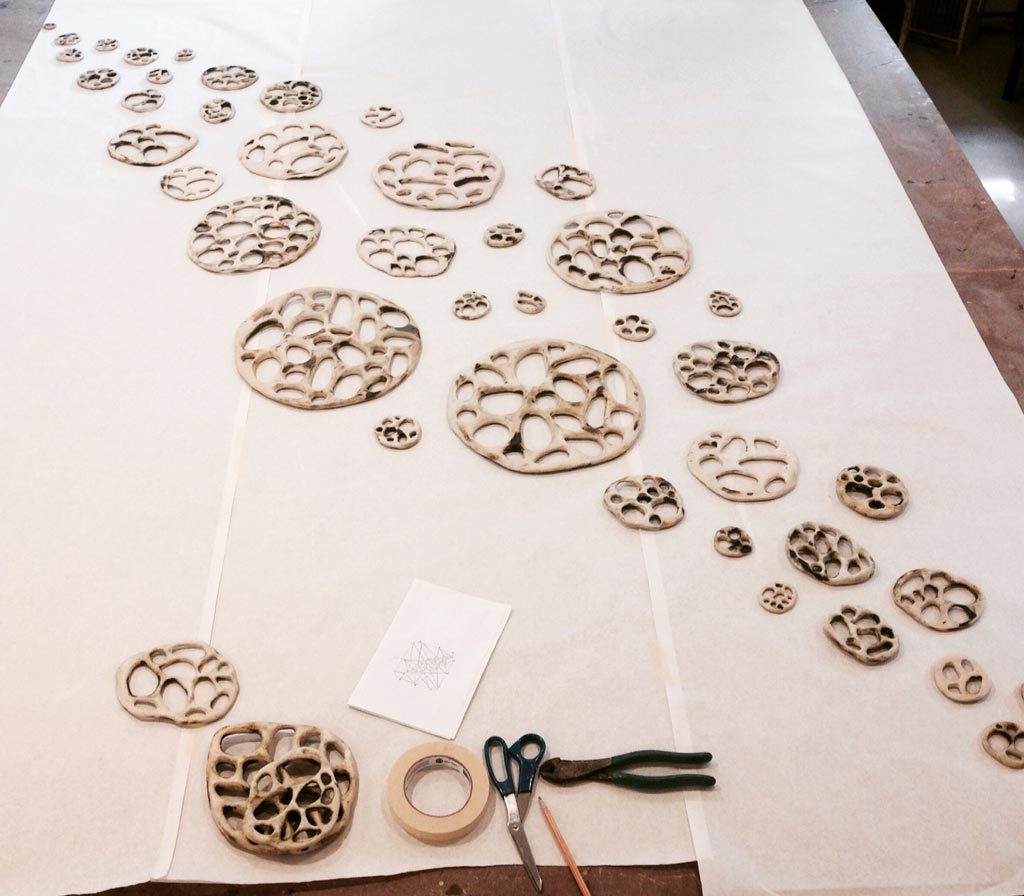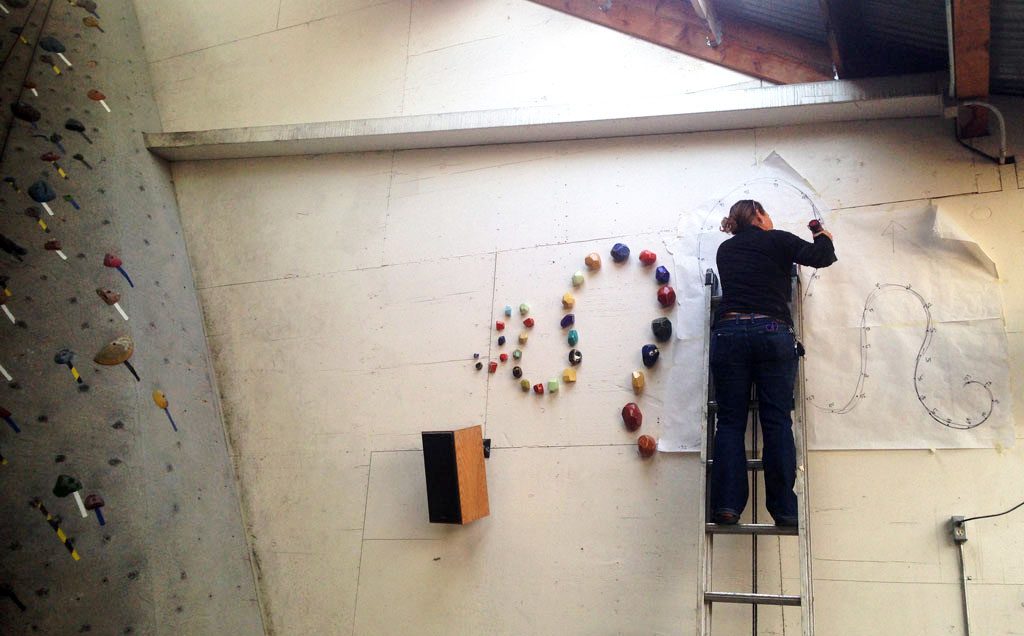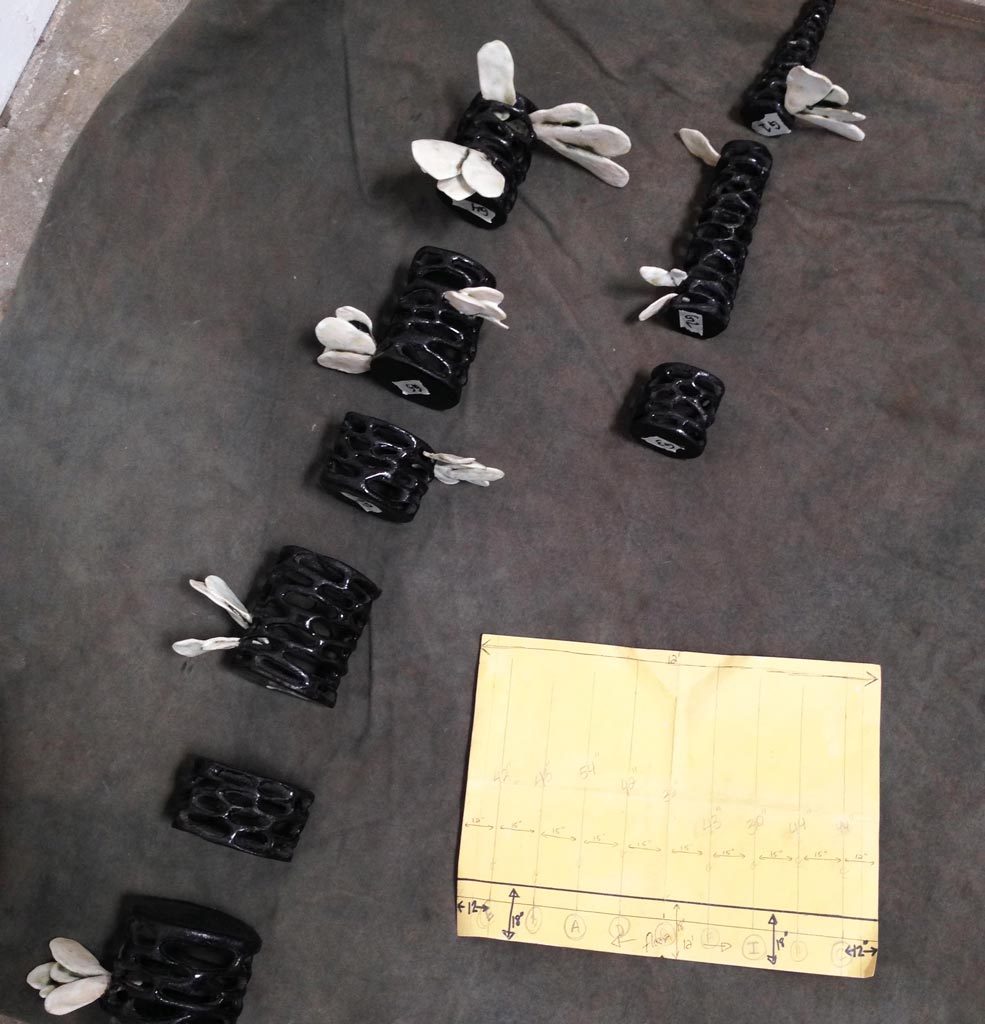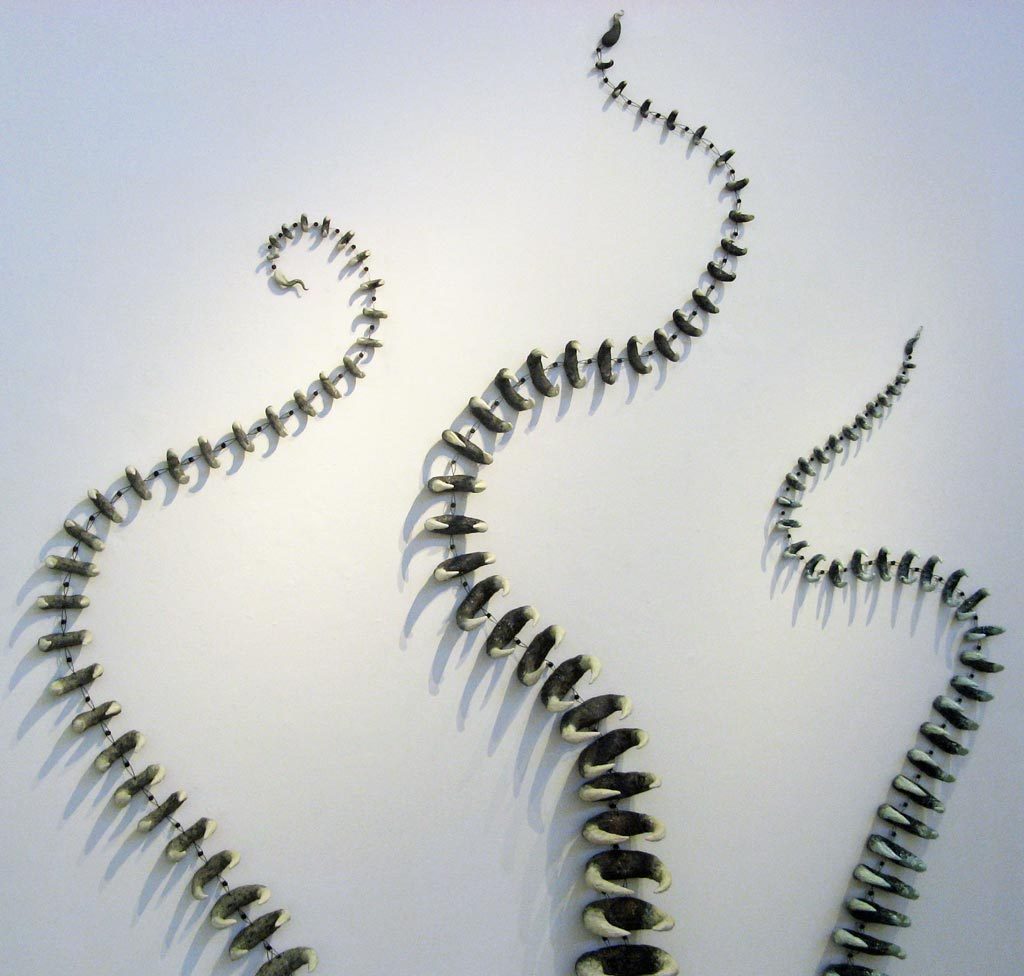Packing up the 200 pieces from my Hive Series to ship off to Portland is no small feat. Each piece is wrapped in bubble wrap, those pieces are boxed up, the boxes are crated up and the crate will get picked up and shipped off soon. Fingers crossed everything survives the journey. Can’t wait to see this piece installed as a part of The Evocative Garden NCECA 2017 exhibit at the Disjecta Contemporary Art Center.
Tag: Life In The Studio
Video: Carving Hive Series
I’m making a few extra pieces for my Hive Series installation which will be exhibited at the Disjecta Contemporary Art Center in Portland for NCECA 2017. There are about 200 pieces that make up this installation but just in case some don’t survive the shipping, I thought a few extra would be a good idea. Here’s a quick video of the carving process to make the ends have a web-like structural feel to them. It’s the most time consuming part of the whole process, but the results are pretty beautiful! Enjoy…
Prepping for an installation
When you work in parts to make multipart installations, it’s easy for things to get mixed up. Whether it’s in the kiln or in the glazing process, it’s very easy to confuse yourself on where you planned for everything to go. This is especially true when you are doing an installation in a gallery space, a time when you want to be organized and intentional with your work. This is especially hard when you’ve never installed the piece in its entirety yet. This uncertainty is also what I love about installations, a sort of do or die moment when you may have to improvise to make it all happen the way you want.
Here’s a glimpse into how I keep things organized. I am a huge fan of the paper template. I plan out everything on a very large piece of paper and usually do as much layout as I can on the floor in my studio. Once I’m happy with the layout, then I decide which pieces go where. Each piece is identified by a number that corresponds to it’s spot on the paper template.
When I get to the space, the paper template gets hung up first. This is a really simple way for me to envision how the piece will actually work in the space and it’s easy to move around if I decide that the original plan doesn’t work. Once I’m happy with the placement, then I start attaching the hardware, usually screws or hooks that will hold the pieces to the structure. I remove the paper template as I start attaching the pieces.
In the case of having multiple parts in a multi piece installation, as in my Lichen Series or Vine Series, then I use a layout map with measurements of each of the pieces, so that they are composed to interact with each other while still holding their own in the space they occupy. This is especially important to keep the flow of a piece visually stimulating, again, I usually do as much layout as I can on my studio floor before making final decisions on the layout.
The Lichen Series has 9 stalks each with 9 parts to it, it can get a little confusing, so each piece is labeled and boxed to correspond to the map. The Vine Series has 9 vines total each with 36 parts and as similar as they are, the parts are not interchangeable between each vine so it’s important that everything stays organized.
I also find that this is a really helpful system if you are not the one installing your own art. I try to imagine the handling team at a gallery or museum unpacking my art and seeing it for the first time in person. Putting yourself in their shoes makes you pay attention to the details that come as second nature to the artist. Explaining and labeling are the keys to making sure your art shines. I’m sure that other artists have different ways of planning out a multipart installation which I’d love to hear about, so please share if you’ve got a great system!
BUY ART
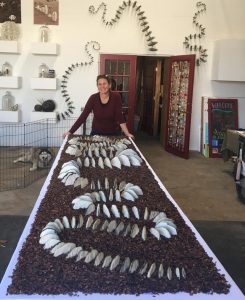 There is a notion that buying art is only for the elite, those with large enough spaces to house art and that you must be educated in the field in order to make good purchases. All of that is wrong. One of the best lessons I learned wine tasting is that it doesn’t matter what the bottle costs or whose top ten list it’s on. What matters is that I like the way it tastes. Duh, right?
There is a notion that buying art is only for the elite, those with large enough spaces to house art and that you must be educated in the field in order to make good purchases. All of that is wrong. One of the best lessons I learned wine tasting is that it doesn’t matter what the bottle costs or whose top ten list it’s on. What matters is that I like the way it tastes. Duh, right?
The same applies to art. If you like it, you like it. Maybe you can go deeper into figuring out why you like it, whether it’s an emotional connection to a piece or a connection to the material it’s made out of. Whatever the reason, if you connect with a piece you want to surround yourself with it, just like a wine you enjoy can round out a meal, a piece of art can round out your space.
Maybe you can’t afford the piece you connect with or you don’t have a wall big enough to hang it on, this happens to me all the time, but the good thing is that most artists make work in a variety of size and price ranges which can make taking home a piece of their work affordable to nearly everyone.
You are of course welcome to just come and look but for my Open Studios event this year, I have work priced from $15. and up, affordable for every budget. Thanks for supporting independent artists and buying art!
Doing it all yourself…
Everyone assumes that because you are an artist, you can make anything yourself and maybe we can but do we actually have the time to?
I could make all of our dishes, all the tiles for the floors and counters, and even design logos and signs for my business. They wouldn’t be the best, but I have the skills, tools and materials to do it. But this means that every time I put effort into a creative project like tiling the countertop means that I take away time from making art, so how do you find a balance between the things you can do and the things you should do?
This countertop project was a real thing, I really wanted to make the tiles to mosaic the new studio counter and when I mentioned that to my husband who had just finish building the countertop, his response was, “Do you want to use this surface area in the next few months?” He was joking but he definitely had a point. I need to use the counter in a few weeks when my classes begin again at the studio, so a few coats of polyurethane and a few hours later the countertop was ready to go. Maybe someday in the future I will make the tiles, dry them slow and flat, fire and glaze them, then design the whole surface of the counter into an elaborate mosaic. Maybe.
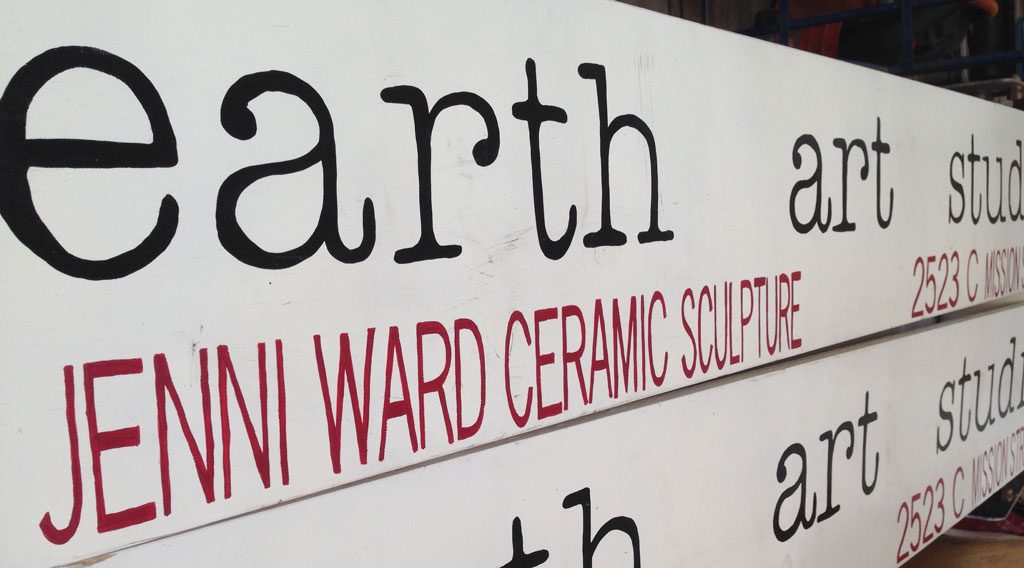
But for now, I’ve settled on making my own numbers for the studio address and I’ve hand painted signs that will hang on the outside of the studio, these things still took hours but not weeks. And I’ve got no plans to make all my own dishes, I will leave that to the much more talented potters that abound in my community. I want my studio to have creative, handmade touches that make the space unique and intriguing for visitors but I also want to have a body of work that I’m proud of and has been given the thoughtful attention and time it deserves.
So with that, I’m going to stop blogging and start working.
Make Your Mark
A few rebels have already done it. A few regulars are really tempted.
Now, it’s time for everyone to TAG the TABLE!
Join us at the Annual Spring Studio Sale and get a chance to make your mark!
Saturday April 30th 11 – 4
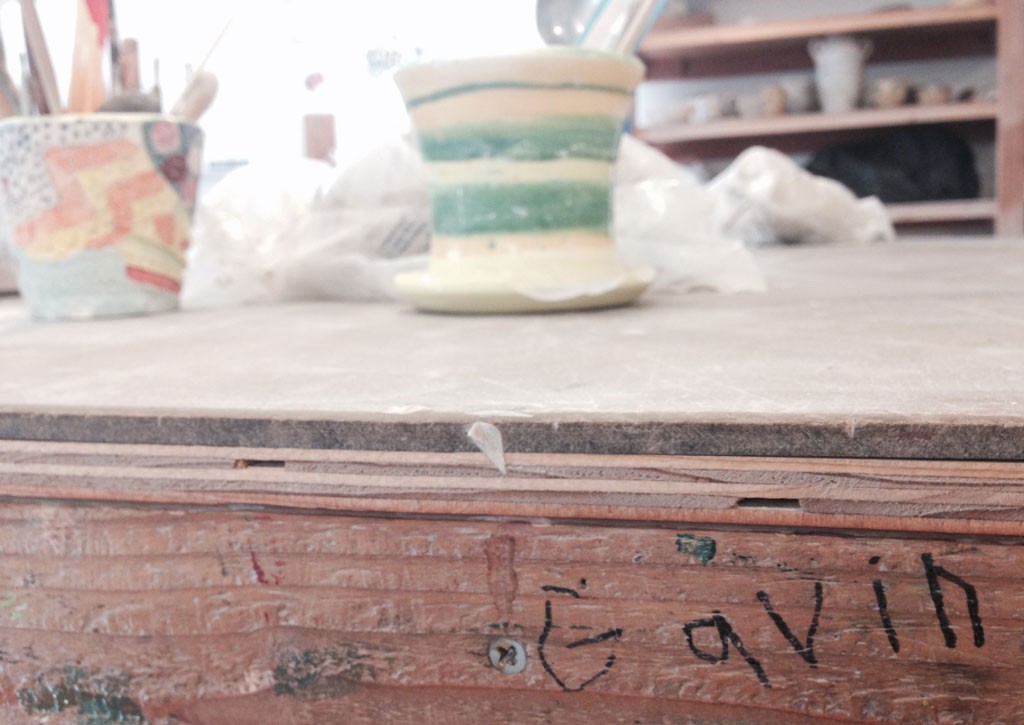 About the Studio Table aka: Joebob Mesa (yes, my studio table has a name):
About the Studio Table aka: Joebob Mesa (yes, my studio table has a name):
At 8′ square, this table dominates the space in my studio and has held up well considering all it has been through over 12 years of use. My husband Nate is over 6′ tall and he designed and built the studio table, which is why it is the perfect height for an over 6′ tall man. What he didn’t realize was that my 5 and 6 year old students were about eye level with the table top, (whoops!) so we ended up getting some very tall stools for these little guys to teeter on. Next time, a lower table is definitely in order!
A few years ago we cut the table down to about 8′ x 7′ to make more walking room around the table. When we started to take it apart, I realized that the side boards had been burnished by hundreds of students hands running over them, it was honestly amazing to look at as a symbol of my time teaching art. And it actually inspired me to invite everyone to sign their name to the table as well. Hope to see you at the studio April 30th from 11 – 4!
Fun Fact: It is very common for clay artists to name their kilns, ours is Fireball, but we also named the throwing wheels; Thing One and Thing Two, the slab roller; Slabby Mc Slabberson and as mentioned above the table is Joebob Mesa. We would’ve named the extruder when it joined the studio this past winter, but it came with the name Super Duper Clay Extruder written right on it and everyone agreed that it really didn’t get better than that.
A Great Art Teacher
I sat in my car by the cliffs on a very wet morning, half watching the waves pummel the coastline and half scrolling through my phone while I contemplated taking the dog out for a walk in this unpredictably drizzly day. I came across this post on NPR about A Great Teacher, this particular article was about an elementary school art teacher.
After reading through the quick and cute illustrated article, I took the dog for a walk (despite the rain) and while we walked I thought about all the great art teachers I had. I tried to remember back if there was a moment that they boosted me up or that they let me down, a defining moment that led me down the path to become an artist and art teacher myself. But all I could remember was that they were my heroes, they were in charge of the space that I wanted to be all day long: the art studio.
 As all these thoughts were mingling in my head, I found myself crouched down in the mud trying to get my camera to focus on these beads of water lined up perfectly on the blades of grass along the path. They were beautiful and tiny and so easy to pass over. I was reminded of a very early art lesson that started with something to the tune of train your eye to see everything, then train your hands to create what you see which was a more poetic was of saying, “We’re sketching landscapes. If you don’t see lollipop shaped trees, don’t draw any.”
As all these thoughts were mingling in my head, I found myself crouched down in the mud trying to get my camera to focus on these beads of water lined up perfectly on the blades of grass along the path. They were beautiful and tiny and so easy to pass over. I was reminded of a very early art lesson that started with something to the tune of train your eye to see everything, then train your hands to create what you see which was a more poetic was of saying, “We’re sketching landscapes. If you don’t see lollipop shaped trees, don’t draw any.”
What if I hadn’t had great art teachers to train my eyes or my hands, where would I be? From elementary to high school to university, this group of talented misfits gave me a safe, creative space to enjoy who I was and become who I am. I am forever grateful.
Awhile back I wrote a post about Why I Teach Community Clay Classes and after 15+ years of teaching, I hope that I’ve done (and continue to do) justice to my responsibilities as an art teacher.
Making Kiln Stilts
I have a decent selection of store bought stilts for the occasional need to glaze a project completely. Most of the stilts are for something at least 3″ across so that the object balances evenly on the stilt, but one of my students wanted to make marbles- smaller than an inch across sized marbles. While I thought her plan of designing and carving these tiny sculptures was a great idea, I also explained that if she wanted to use glaze on the entire surface, I had no way of supporting them in the kiln on my existing stilts. She took a second to think about it and then asked if she could make her own stilts with the nichrome wire that I use in my work often- and she did. We bisque fired her tiny stilts and marbles and when she glazed them, each one was propped on its own individually made stilt and placed in the kiln. They worked brilliantly and since then I’ve started making all of my own stilts.
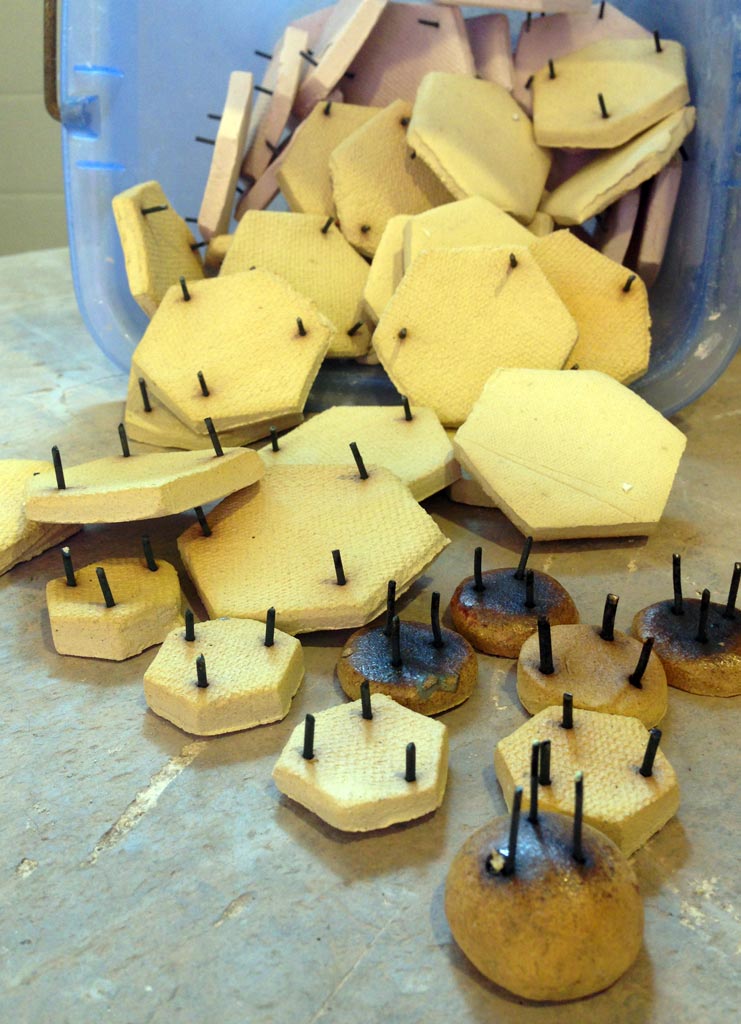
I roll out a slab of clay on my slab roller and use cookie cutters to cut out as many shapes as I can fit on the slab. Then I use nichrome wire and cut it into short lengths, trying to be as consistent as possible with the size and also trying to cut the wire on a sharp angle so that the pointiest part is what will touch the glaze and I stick them evenly spaced into the clay shapes. I use a medium gauge nichrome wire for this, if it is to thin, they tend to sag in the firing while supporting your piece or wear out quickly, too thick and they leave a heavier mark in the glaze for you to grind out afterwards. If you have left over element pins, these work great too for holding sturdier pieces. Each piece is dried and bisque fired and then you are good to go. My stilts get a lot of kiln time and eventually wear out but then I just crank out a new batch and I’m set to go again.
I love that the ingenuity of my students, not only made me look at my existing supplies in a new way but they also don’t let the studio limitations limit their work. #mystudentsrock
Studio Tour
If you’ve never been to the studio or you haven’t visited me in awhile, now is your chance to check out all the new and fun things going on at my studio in the redwoods. Click play on the video to take a virtual tour of my studio. You are always welcome to make an appointment to tour the studio in person too!
New Video!
I’ve just launched a new video on my You Tube channel! I’m making these pieces for a custom order and thought it would be a great opportunity to share the process. This is a quick time lapse video of me making a sprout form in the studio, the video is less than a minute long but the piece took about a 20 minutes to make. The next steps are for it to dry completely, be fired in the kiln for about 10 hours, then glazed and fired once more. I’ve made hundreds of these little sprouts to be used as the inside pieces of my Nest Series. A few of these pieces were also featured in the Fire & Water In the Field Series. I hope this helps you understand all the work that goes into making even the smallest of pieces. Enjoy the video and let me know what you think!
